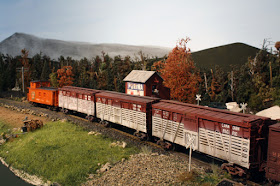 |
| This type of sign was used on Ontario's public highways from 1960-1993.
Similar signs with larger printing were in use between 1930 and 1962.
This particular sign was photographed at Memory Junction Museum in
Brighton, Ontario on August 01, 2015. |
Photo and Observations by Peter Mumby
One
thing that can be said about today's digital culture is that it has
turned almost everybody into a photographer. If you need accurate road
signs for your modern-era layout, take a few photos, download to your
computer, re-size them, and print what you need. If you want to
document the colour of City of London service vehicles, wait for the
next construction slowdown, lean out the car window, and grab the shot
you desire. If, however, your layout is set in the 1950s or 1960s, data
collection is not quite so straightforward. Just what did road signs
look like at that time? How were highway maintenance vehicles
decorated?
You'd think you could ask someone like me anything you
needed to know. Since my years from birth to high school graduation
spanned the 1949 - 1967 era, I should be a fount of all such knowledge.
But memory only goes so far, and back then cameras were only brought
out for "special occasions." How often have I wished that I had
photographed the mundane items of everyday life?
My hometown of
Port Hope, Ontario was the site of a District Office of the DHO
(Department of Highways, Ontario). During the season of winter road
conditions (mid-November to mid-April), the provincial highways were
patrolled around the clock. The year I was in grade 12, (1966/67), I
was one of three high school students hired as a telephone/teletype
operator for weekend shifts. We were responsible for dispatching
snowplow operators and preparing district road reports every four hours
for forwarding to headquarters at Downsview. If you remember radio
commentators saying things like " highway two between Cobourg and
Grafton is bare to centre-bare with slushy sections", this is the jargon
that was my stock in trade. I saw lots of equipment around the
district office, but taking photographs never crossed my mind. DHO
vehicles as I recall were yellow with black lettering, but what shade of
yellow? and what type face in black? These are the little details that
can really set your layout apart!
Ontario's public highways have
been numbered since 1925. The DHO was formed in 1930, and since then
all primary highways have been designated as "The King's Highways".
There was never a Highway 1, but the numbers 2-427 have been used. In
1972 the DHO was re-branded as the MTC (Ministry of Transportation and
Communications); in 1987 this morphed into the MTO (Ministry of
Transportation, Ontario). Through it all, the name "The King's Highway"
has remained, although this slogan disappeared from the actual road
signs starting in 1993. The size of the provincial road system shrunk
dramatically between April 1997 and January 1998 as approximately 4980
km of highways were downloaded by the province to local and county
governments. Much of the actual maintenance work previously carried out
by the DHO is now done by private contracting companies.
So, the
era you model can have quite an impact on the roadside signs and
maintenance equipment that you apply to the layout. Fortunately, local
museums and private collectors have been good about preserving such
items and information. Take that digital camera with you, and
photograph your way to a more realistic highway setting. The accurate
vehicles available today deserve that kind of attention to detail!
For
those of you interested in more research on the signage and history of
Ontario's provincial road system, check out the website on "History of
Ontario's Kings Highways".

















































